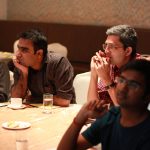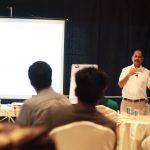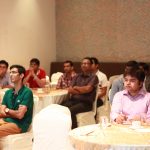- November 7, 2014
- Posted by:
- Category:Bengaluru, BLOG, Events, Speaker Events
Contributed by: Aneek Saha, CFA
Bengaluru chapter of IAIP conducted an event titled Jyothy Laboratories – An Amazing Journey by Ullas Kamath, Joint MD and CFO of Jyothy Laboratories. Ullas is a compelling speaker and a wonderful teacher, who shared with us his insights on business and life. In many cases the insights, he gave, flew in the face of conventional wisdom. Ullas’ talk was organized into three main parts: A brief company overview about Jyothy Laboratories, the story of the Henkel Acquisition and the role of a CFO in an FMCG company.
M P Ramachandran started Jyothy Laboratories in 1983 and Ullas joined Jyothy labs in 1991. The company has evolved from having one brand – Ujala to a portfolio of brands including Ujala, MAXO, Exo, Pril, Margo, Henko, Fa, Mr. White, Check and Neem. Factories have been set up at rural and backward areas including disturbed areas like Jammu, Mehboobnagar, Guwahati, Bankura etc. In all they have 34 factories in 17 locations. Their typical factory employee is the rural Indian woman and the company considers empowering them as a part of their Corporate Social Responsibility. Furthermore locating factories in these far-flung areas, enables the company to enjoy fiscal benefits offered both from state and central governments. A CFO should be aware of all such fiscal benefits before setting up manufacturing facilities. Jyothy has thus created more than 5000 such jobs. The company has an extensive distribution network covering 2.9 million outlets; the field sales force alone cover 1 million retail outlets. The company trains hardworking employees with the required skills so that they become smart at work. He also talked about when given a task, hard working people ask “how ?” and delve less time into asking “why?”. They are eager to work hard and get the job done. An important staff welfare measure to retain loyal employees is a Home loan from the company. In turn the employee reciprocates with her loyalty; indeed the attrition rate of the company before the Henkel acquisition was below 1%.
As per Ullas, to sell branded goods, humility, rather than intelligence is required. Being able to communicate in the local language and being able to build strong relationships with the shop-owner can bring in as much as 25% extra sales. The company involves salespeople in decision-making. The opinion of salespeople is more valuable in making the right decision than the inputs from market research and consulting companies – because market research and consulting companies rarely stick their neck out and seldom give a concrete suggestion.
Ullas also told us the fascinating story of the Henkel acquisition. Most analysts had written off the move as being an unwise one. He had a radical plan to turn around the company. He had worked out to the last detail of how value would be created to bring about a robust turn around in the company fortunes. Two takeaways from this case study are: one, that doing one’s homework, analyzing the situation in detail and being prepared are priceless in a negotiation, and two, negotiation is like a game of poker, you need to make the player on the other side show his cards while keeping yours close to your chest. He also made the case that the logic to acquire any company should be very specific and visible. Value addition by the acquirer should be measurable. A well run company if acquired and if one can not add value to build the topline and the bottom line then value can only be eroded over a period of time. That’s why more than 2/3rd of M&A in the world are failures.
He also gave valuable advice regarding a typically successful FMCG company. Such a company typically has gross margins not less than 25%-30% of Sales, Advertisement and Sales Promotion expenses at 10-12% of Sales, EBIDTA at 15%, and a PAT of 10%. If a company fulfills these criteria, one can rarely go wrong with the company. Working capital for a well-run branded goods FMCG company can be 10-15 days of sales. Three months of advertisement expenses should be kept in the bank. As per business planning, the CFO should aim to generate 20-25% topline growth and work backwards from there. Once the topline is achieved, the scale advantage sets in, advertisement budgets can be cut and overhead expenses can be reduced to boost profits.
On the question on whether to use debt or equity, Ullas’ stake was the decision between debt and equity should be based on the timing, cost of debt and valuation of equity. If the cash flow in the company is good debt is preferred. In a good time if one can get great valuation equity is preferred. If interest coverage can be higher than 6 times, then debt is the best, as it is tax efficient too. On E-Commerce he said it is a 3-10-15 years phenomenon. Players are spending to build the category at huge losses by giving unsustainable deep discounts to woo the customers. All such expenses are funded through equity. E-commerce would not be able to replace FMCG products stocking retail outlets, which are more than 50 million in India.
– AS








